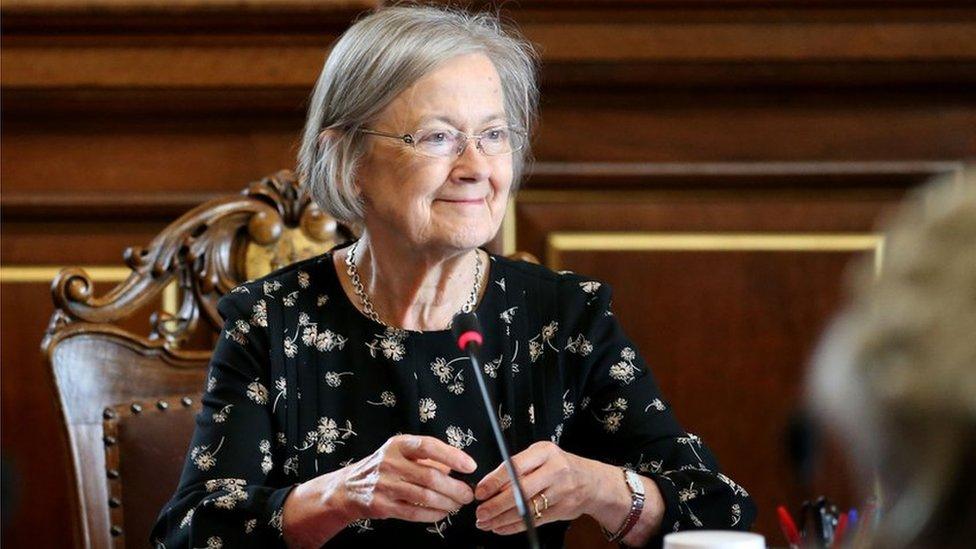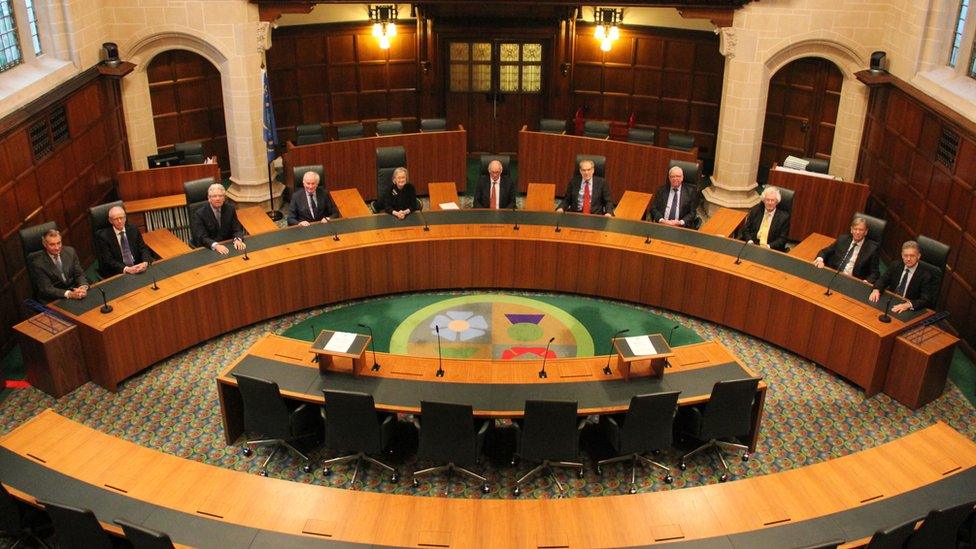Baroness Hale: The Supreme Court trailblazer
- Published

Lady Hale is the first female president of the UK's highest court
Forthright in her views and a champion of diversity, Baroness Hale is a trailblazer whose life has been full of firsts.
Born in Yorkshire, Brenda Hale is a grammar school girl whose parents were both head teachers.
She achieved the only starred first in her year at the University of Cambridge, before going on to be the youngest person and first woman to be appointed to the Law Commission.
Lady Hale played a significant role in introducing a number of reforms to the law, including the Children Act 1989, which is widely acknowledged as the UK's most important piece of legislation protecting children.
In 2004, she became the first woman to be appointed as a Law Lord.
When the Law Lords - who had sat in parliament as the Appellate Committee of the House of Lords - were given a new home in 2009, with the establishment of the UK Supreme Court, she became its first female justice.
In 2013, she became its first deputy president and today becomes its first female president.
But her route to becoming the most senior judge in the UK has been anything but conventional.
First woman appointed as UK's top judge
Unlike her fellow Supreme Court justices, Lady Hale spent many years in academia rather than legal practice. She remains an educator to the core.
In 1966, she became an assistant lecturer at the University of Manchester, where her interests were in social welfare and family law.
She remained at the university for 18 years while also qualifying as a barrister.
It is no surprise that she did so by achieving the highest mark in her year in the Bar Final exams in 1969.
She followed this by developing a part-time practice in family law, which she managed to combine with her academic work.
With her burgeoning CV, it was perhaps only a matter of time before she was appointed a judge in the family division of the High Court.
She was the first academic - yet another first - to achieve such a move in 1994.
She continued to play a role in legislative reforms, such as the introduction of the Family Law Act 1996, which covered domestic violence, and the Mental Health Act 2005.

Lady Hale, front left, had been deputy president of the Supreme Court
Lady Hale has always been acutely aware of the need for judges to be drawn from a diverse group within society.
She has been all too conscious that diversity has been a stubbornly difficult problem for the judiciary to overcome and that it remains a major issue.
Figures on judicial diversity released on Thursday, external show some progress in the last three years among senior judges.
The percentage of female judges in the Court of Appeal has risen from 18% to 24%, and from 18% to 22% in the High Court.
But there is still a woeful lack of diversity, with just 28% of court judges being female and only 7% coming from black and minority ethnic backgrounds.
Shortly after her appointment as the first female Law Lord in 2004, while speaking in a lecture, she said the gender and ethnicity of judges matters "because democracy matters".
"We are the instrument by which the will of Parliament and government is enforced upon the people. It does matter that judges should be no less representative of the people than the politicians and civil servants who govern us."
'Quadrangle to quadrangle'
But she hasn't always been so diplomatic.
In 2011, with typical candour, she said she found it "quite shocking" that so many senior judges were members of the all-male Garrick Club, a private members' club in London's West End.
She suggested its popularity might contribute to male dominance of the bench, thanks to "personal network relationships".
She has talked about the background of her fellow senior judges, who have moved from public school to Oxbridge colleges, to the Inns of Court, as being "from quadrangle, to quadrangle, to quadrangle".
She acknowledges that she herself is part of the quadrangle by dint of going to Cambridge.

Last year, the Supreme Court ruled against the government in the Article 50 case
As a Supreme Court justice she has been the court's magnetic north on matters of family law.
In 2011, in the housing case Yemshaw v LB Hounslow, she gave the lead judgement ruling that domestic violence was not limited to physical violence.
In 2014, she effectively broadened the definition of what amounts to a deprivation of liberty for those who lack mental capacity and are detained in care homes and other institutions, writing famously in her judgement that "a gilded cage is still a cage".
There has also been controversy.
Lady Hale was criticised by Brexiteers for comments in a lecture to students in Malaysia, in which she appeared to speculate on aspects of legal questions in the Article 50 case before it had been heard by the court.
She was forced to say publicly that she would not recuse herself from the case.
She now faces huge challenges.
Most importantly, she will have to steward the UK Supreme Court through the Brexit and post-Brexit period in which it will have to determine the weight to be given to decisions of the European Court of Justice.
The UK's relationship with what is in effect the Supreme Court of the EU remains highly contentious, and the eyes of the pro-Brexit press, in particular, will focus laser-like on decisions of our own Supreme Court on issues of EU law.
If she receives some personal criticism in the press, that will not be a first.
- Published21 July 2017
